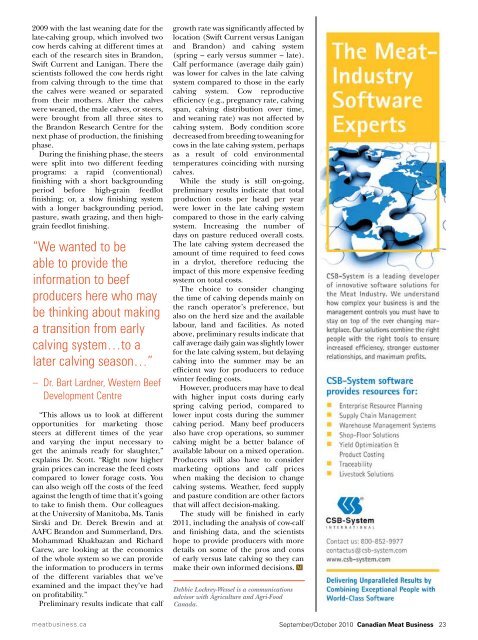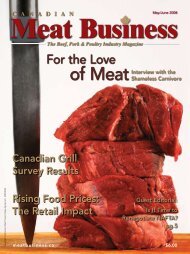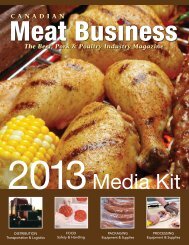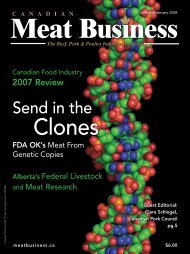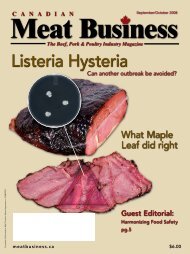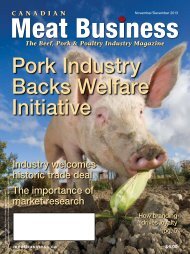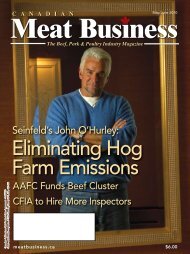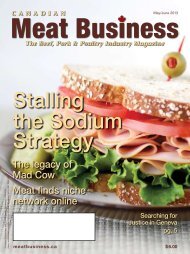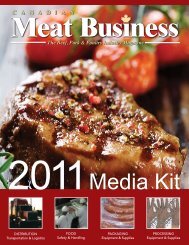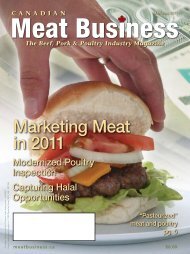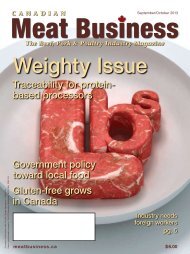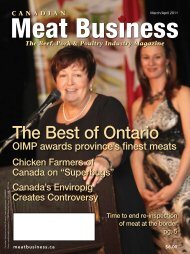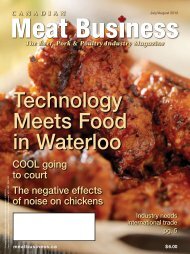Ralph Cator
Joining Meat Hall's Class of 2010 - Canadian Meat Business
Joining Meat Hall's Class of 2010 - Canadian Meat Business
You also want an ePaper? Increase the reach of your titles
YUMPU automatically turns print PDFs into web optimized ePapers that Google loves.
2009 with the last weaning date for the<br />
late-calving group, which involved two<br />
cow herds calving at different times at<br />
each of the research sites in Brandon,<br />
Swift Current and Lanigan. There the<br />
scientists followed the cow herds right<br />
from calving through to the time that<br />
the calves were weaned or separated<br />
from their mothers. After the calves<br />
were weaned, the male calves, or steers,<br />
were brought from all three sites to<br />
the Brandon Research Centre for the<br />
next phase of production, the finishing<br />
phase.<br />
During the finishing phase, the steers<br />
were split into two different feeding<br />
programs: a rapid (conventional)<br />
finishing with a short backgrounding<br />
period before high-grain feedlot<br />
finishing; or, a slow finishing system<br />
with a longer backgrounding period,<br />
pasture, swath grazing, and then highgrain<br />
feedlot finishing.<br />
“We wanted to be<br />
able to provide the<br />
information to beef<br />
producers here who may<br />
be thinking about making<br />
a transition from early<br />
calving system…to a<br />
later calving season…”<br />
– Dr. Bart Lardner, Western Beef<br />
Development Centre<br />
“This allows us to look at different<br />
opportunities for marketing those<br />
steers at different times of the year<br />
and varying the input necessary to<br />
get the animals ready for slaughter,”<br />
explains Dr. Scott. “Right now higher<br />
grain prices can increase the feed costs<br />
compared to lower forage costs. You<br />
can also weigh off the costs of the feed<br />
against the length of time that it’s going<br />
to take to finish them. Our colleagues<br />
at the University of Manitoba, Ms. Tanis<br />
Sirski and Dr. Derek Brewin and at<br />
AAFC Brandon and Summerland, Drs.<br />
Mohammad Khakbazan and Richard<br />
Carew, are looking at the economics<br />
of the whole system so we can provide<br />
the information to producers in terms<br />
of the different variables that we’ve<br />
examined and the impact they’ve had<br />
on profitability.”<br />
Preliminary results indicate that calf<br />
growth rate was significantly affected by<br />
location (Swift Current versus Lanigan<br />
and Brandon) and calving system<br />
(spring – early versus summer – late).<br />
Calf performance (average daily gain)<br />
was lower for calves in the late calving<br />
system compared to those in the early<br />
calving system. Cow reproductive<br />
efficiency (e.g., pregnancy rate, calving<br />
span, calving distribution over time,<br />
and weaning rate) was not affected by<br />
calving system. Body condition score<br />
decreased from breeding to weaning for<br />
cows in the late calving system, perhaps<br />
as a result of cold environmental<br />
temperatures coinciding with nursing<br />
calves.<br />
While the study is still on-going,<br />
preliminary results indicate that total<br />
production costs per head per year<br />
were lower in the late calving system<br />
compared to those in the early calving<br />
system. Increasing the number of<br />
days on pasture reduced overall costs.<br />
The late calving system decreased the<br />
amount of time required to feed cows<br />
in a drylot, therefore reducing the<br />
impact of this more expensive feeding<br />
system on total costs.<br />
The choice to consider changing<br />
the time of calving depends mainly on<br />
the ranch operator’s preference, but<br />
also on the herd size and the available<br />
labour, land and facilities. As noted<br />
above, preliminary results indicate that<br />
calf average daily gain was slightly lower<br />
for the late calving system, but delaying<br />
calving into the summer may be an<br />
efficient way for producers to reduce<br />
winter feeding costs.<br />
However, producers may have to deal<br />
with higher input costs during early<br />
spring calving period, compared to<br />
lower input costs during the summer<br />
calving period. Many beef producers<br />
also have crop operations, so summer<br />
calving might be a better balance of<br />
available labour on a mixed operation.<br />
Producers will also have to consider<br />
marketing options and calf prices<br />
when making the decision to change<br />
calving systems. Weather, feed supply<br />
and pasture condition are other factors<br />
that will affect decision-making.<br />
The study will be finished in early<br />
2011, including the analysis of cow-calf<br />
and finishing data, and the scientists<br />
hope to provide producers with more<br />
details on some of the pros and cons<br />
of early versus late calving so they can<br />
make their own informed decisions.<br />
Debbie Lockrey-Wessel is a communications<br />
advisor with Agriculture and Agri-Food<br />
Canada.<br />
meatbusiness.ca<br />
September/October 2010 Canadian Meat Business 23


